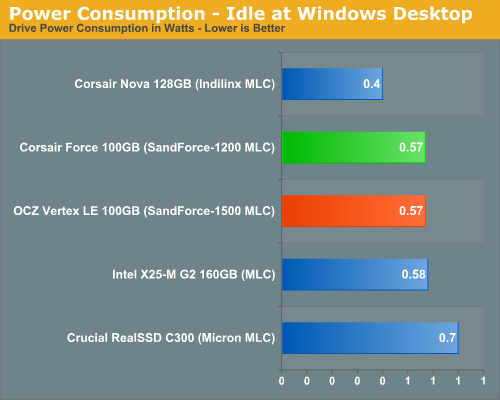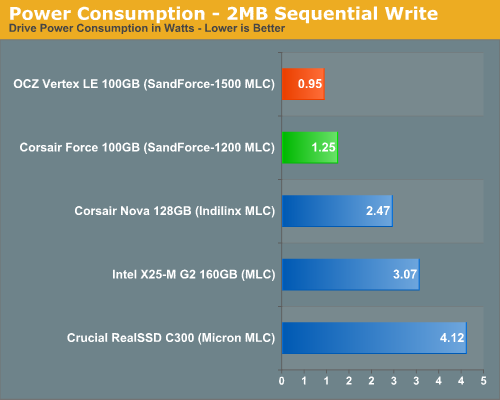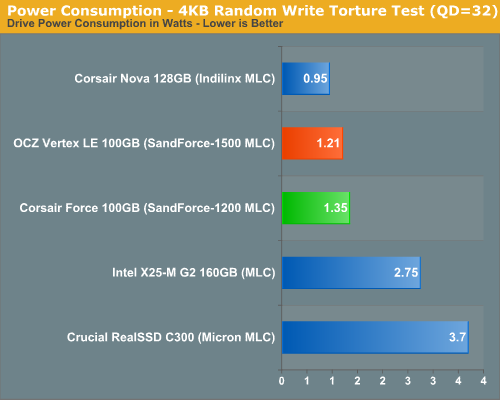Corsair's Force SSD Reviewed: SF-1200 is Very Good
by Anand Lal Shimpi on April 14, 2010 2:27 AM ESTPower - A Telling Story
I'm quietly expanding our SSD test suite. I haven't made the results public but you'll see them in the coming months appear in articles and in Bench. One of my tests happens to be a power consumption test where I measure how much power the drive itself requires during a few scenarios. The results with the SandForce SSDs in particular were fascinating enough for me to unveil some of these numbers a bit earlier than I'd originally planned.
In an SSD you have two main consumers of power: the controller, any external DRAM and the NAND. Now as long as you're not bound by the speed of the controller, the biggest consumer of power should be the NAND itself. Now here's where things get interesting. SandForce's DuraWrite technology should mean that there's far less writing to NAND going on in the Corsair Force drive compared to more conventional SSDs. Unless the controller consumes an absurd amount of power, we should see this reflected in the power numbers.
Note that I am not running with Device Initiated Power Management enabled, which is disabled by default in desktop installations of Windows. Power consumption in a notebook will be lower on drives that support it but I'll save that for another article.

At idle the two SF drives and Intel's X25-M G2 consume roughly the same power. Crucial's C300 is a bit more power hungry while the Indilinx based Nova is noticeably lower.

The highest power draw scenario is a sequential write test. The NAND is being written to as quickly as possible and thus power consumption is at its highest. Here we have proven our hypothesis. The SandForce drives are writing less than the competition and thus their power consumption is less than half of the Intel and Crucial drives. Based on the power numbers alone I'd say that SandForce's compression is working extremely well in this test possibly only writing about half as much data to the NAND itself. In practice this means the controller has less to track, the NAND has a longer lifespan and performance is very competitive.

In our random write test, the power gap between the SF and Intel drives narrows but not tremendously. The Indilinx drive actually beats out the SF offerings but I have a feeling that's because we're actually more controller bound here and the data just isn't getting out to NAND.
Another curious observation is the fact that the SF-1200 based Corsair Force actually draws more power than OCZ's Vertex LE. It's not noticeable in real world desktop use, but it's odd. I wonder if the SF-1200s are really just higher yielding/lower binned SF-1500s? Perhaps they draw more power as a result?
The Test
| CPU | Intel Core i7 965 running at 3.2GHz (Turbo & EIST Disabled) |
| Motherboard: | Intel DX58SO (Intel X58) |
| Chipset: | Intel X58 + Marvell SATA 6Gbps PCIe |
| Chipset Drivers: | Intel 9.1.1.1015 + Intel IMSM 8.9 |
| Memory: | Qimonda DDR3-1333 4 x 1GB (7-7-7-20) |
| Video Card: | eVGA GeForce GTX 285 |
| Video Drivers: | NVIDIA ForceWare 190.38 64-bit |
| Desktop Resolution: | 1920 x 1200 |
| OS: | Windows 7 x64 |










63 Comments
View All Comments
hybrid2d4x4 - Wednesday, April 14, 2010 - link
Thanks for the power consumption charts, Anand! Any chance you can throw in a typical 2.5" 5400RPM HDD that usually comes stock in most laptops as a reference point for those of us who are thinking of upgrading? Also, could keeping Device Initiated Power Management disabled account for the significant discrepancies between your numbers and the recent article on Tom's HW? (ie: Tom's got an idle of 0.1W for the intel drive- a lot better than the competition)http://www.tomshardware.com/reviews/6gb-s-ssd-hdd,...
Impulses - Wednesday, April 14, 2010 - link
The Nova seems to do surprisingly well under Anand's heavy workload test, compared to other Indillix-based drives... Altho it's performance is just average (and similar to other Indillix drives) in most other tests. Isn't the Nova essentially the same thing as the OCZ Solid 2? (and the G.Skill Falcon II) That drive has been priced VERY competitively from what I've seen, I'm surprised there isn't more buzz around it. Looking forward to Anand's review of the Nova.I might be buying soon as a gift for my sister, she really needs more than 80GB for her laptop (80GB X25-M is still the best bang for the buck out there imo), so a $300 120GB is right up her alley.
_Q_ - Wednesday, April 14, 2010 - link
Sorry for being a little off-topic (still SSD though)...Are there any news on when is the Indilinx JetStream going to be released in some drive from any vendor?
Cause as far as I know, this was initially going to be out in end of 2009, then there was a delay... but no further info that I could find more recently.
Thanks for any help.
Hauraki - Wednesday, April 14, 2010 - link
I'm thinking to buy a SSD for system drive and the v+ 2nd gen appeared to be a decent choice for home use. Only got review on X-bit and Hexus so far, would like to see an Anand review.Thanks.
IvanChess - Wednesday, April 14, 2010 - link
"The Mean Time To Failure numbers are absurd. We’re talking about the difference between 228 years and over 1100 years. I’d say any number that outlasts the potential mean time to failure of our current society is pretty worthless."Well said!
Rindis - Thursday, April 15, 2010 - link
But think of the future!In a couple thousand years, when very little is remembered of this time, entire dissertation papers on early 21st century culture will be written based on the contents of your hard drive!
(And if that isn't a scary thought, I don't know what is....)
stalker27 - Thursday, April 15, 2010 - link
Was wondering if the charts could be fixed to correctly display the HDD values for random ops?Something like if the value doesn't fit in the bar it should be displayed after the bar, to its right... and not to its left as it does now colliding with the name of the HDD.
BTW, that was actually a factor I'm looking into seeing in SSD reviews... how good are they at the really useful operations, not that sequential doesn't matter, that much.
zzing123 - Thursday, April 15, 2010 - link
Given the SandForce controllers effectively compress data on the drive, I'm just curious about precisely how much data you can write to the drive...For example, if data is say text, and you create a 1MB text file, how many of those 1MB text files can you physically store on the drive versus another non-SandForce drive? Just a curiosity.
xilb - Thursday, April 15, 2010 - link
the OCZ LE isnt using the SF-1500only the vertex 2 pro is using the SF-1500 and the vertex 2 is using SF-1200
the LE has a chip that sort of in the middle of the 2 .........look it up on the OCZ forms you will see
paulpod - Thursday, April 15, 2010 - link
Needless to say the author is completely wrong about what a MTBF number means. That number has nothing to do with infant mortality rate nor with life expectancy. It is the statistical failure rate over a large number of units operating in their prime life period.